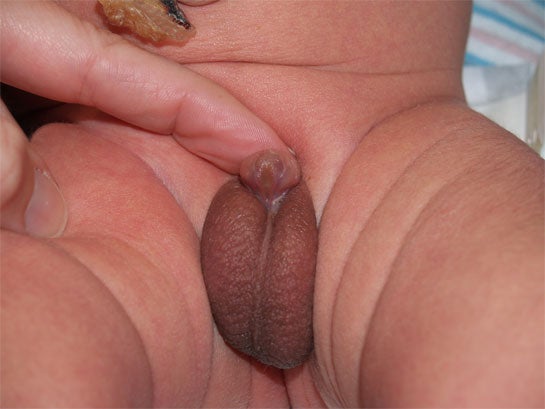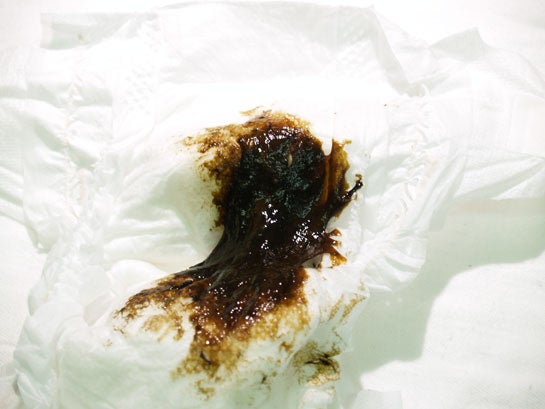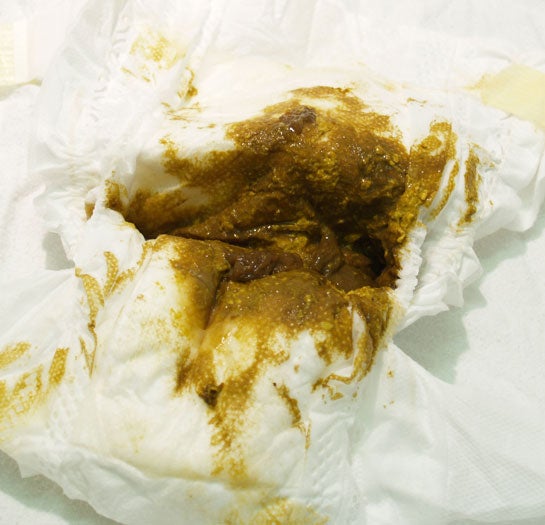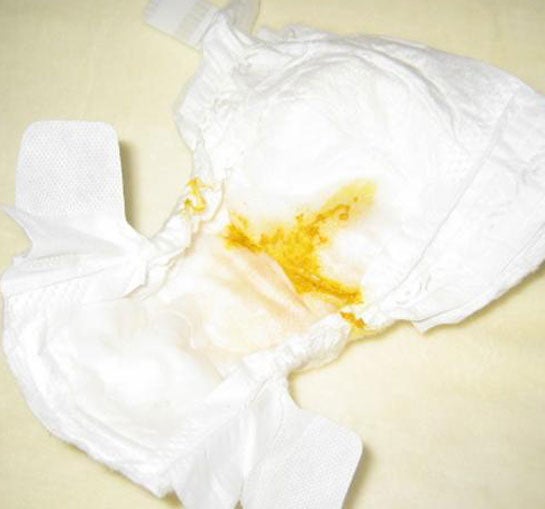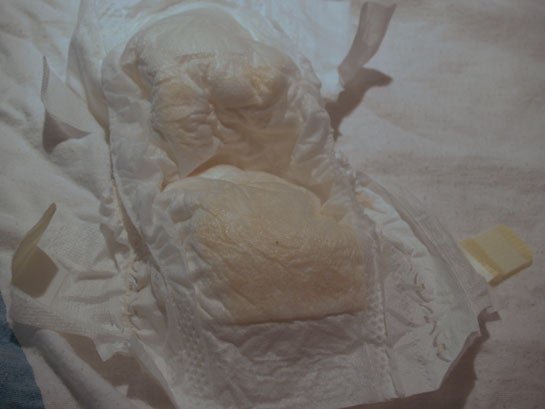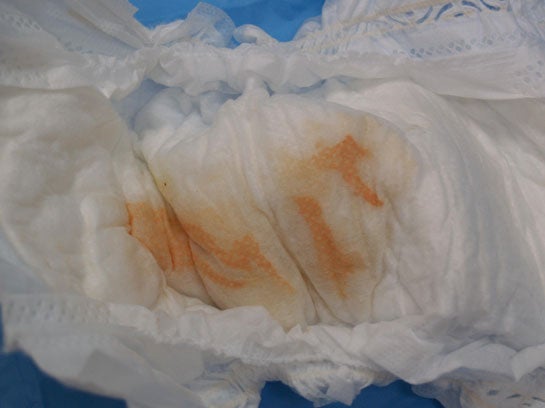MALE AND FEMALE GENITALIA, FEMORAL PULSE ASSESSMENT
GENITOURINARY(GU) ASSESSMENT: URINE AND STOOLS
Unfasten the diaper. Always cover the penis with the diaper or you may be surprised with a shower.
Female Genitalia
The clitoris is usually edemetous. The labia majora usually covers the labia minora. In premature infants, the labia minora is prominant. In the picture below the white material is vernix caseosa. The infant may have pseudomenstruation
The infant may have pseudomenstruation caused by maternal hormones. This can cause a mucoid (left picture), or pink or blood-tinged discharge (diaper, right picture). There can be a vaginal skin tag. The black liquid (left picture) is the meconium, or the first stool and should be passed in the first 24-48 hours after birth. Meconium lasts 24 hours and is sticky and thick. It indicates that the anus is patent.
caused by maternal hormones. This can cause a mucoid (left picture), or pink or blood-tinged discharge (diaper, right picture). There can be a vaginal skin tag. The black liquid (left picture) is the meconium, or the first stool and should be passed in the first 24-48 hours after birth. Meconium lasts 24 hours and is sticky and thick. It indicates that the anus is patent.
|
|
|
|
Female genitalia with vernix and meconium stool |
Pseudomenstruation |
Pictures used with permission Dr. Janelle Aby, Stanford Medical School, Palo Alto, CA
Male Genitalia
Observe the penis and scrotum. The picture on the left shows a normal uncircumcised male genitalia.
male genitalia.
- The meatal opening is round and on the tip of the glans penis.
- The scrotum has rugae or wrinkles. If the infant is premature, there may be fewer rugae and the testicles may be undescended. If the scrotum has deep rugae and is more pendulous, the infant is more matue. The color of the scrotum varies from pink to darker brown depending on skin color and maternal hormones.
- With your thumb and index finger, palpate for the presence of the two hard, round testicles, one on each side of the scrotum. If you can't feel the testicle, put your thumb higher on the groin over the inguinal canal and "milk" it toward the scrotum, letting it slide between your index finger and thumb. Undescended testicles
 occur in 3-4% of term infants.
occur in 3-4% of term infants. - The scrotum in the middle picture is a hydrocele
 . The right picture shows a hypospadias.
. The right picture shows a hypospadias.
- The cremasteric reflex occurs when the infant is cold and the testes retract.
|
|
|
|
|
Normal term infant |
Hydrocele |
Hypospadias |
Pictures used with permission Dr. Janelle Aby, Stanford Medical School, Palo Alto, CA
Urine and stools
The first stool and urine should occur within the first 24 hours of birth. Passage of the stool usually indicates a patent anus.
- Meconium is the first stool (below: left picture). It is thick and difficult to wipe off.
- By day 4, the stool changes to a transition stool (below: middle picture). The color is green/yellow/black and seedy in the exclusively breastfed infant.
- After the fifth day, the stool is bright yellow, runny and seedy (below: right picture). Often the parents mistake the breastfed stool for diarrhea. The stool of the breastfed infant is not odorous until the infant begins solid foods at 6 months. Formula fed stool is darker yellow and pasty and malodorous.
|
|
|
|
|
Day 1: Large Meconium Stool |
Day 3: Large Transitional Stool |
Day 5: Small yellow stool |
Pictures used with permission Dr. Janelle Aby, Stanford Medical School, Palo Alto, CA
|
|
|
|
Very wet diaper |
Urate crystals |
Pictures used with permission Dr. Janelle Aby, Stanford Medical School, Palo Alto, CA
Diapers are very absorbent, so it is often difficult to tell if they are wet. Urate crystals are a frequent intermittent finding during the first week. It is a normal variation and needs no lab analysis.
are a frequent intermittent finding during the first week. It is a normal variation and needs no lab analysis.
During the first 24 hours, one wet diaper and one stooled diaper are expected. During the second 24 hours, the infant should have a minimum of 2 wet and 2 stooled diapers. After day 5, the infant should have at least six wet diapers and 2-3 stooled diapers.
At this time you may want to put a clean diaper on the infant. Remember that the designer part of the diaper is in the front and the fastening tabs are in the back. The tabs are brought to the front of the diaper can be reapplied many times. Don't forget to take off the covering over the tabs before you try to fasten them. Much easier than using cloth diapers and safety pins, but not as eco-friendly!
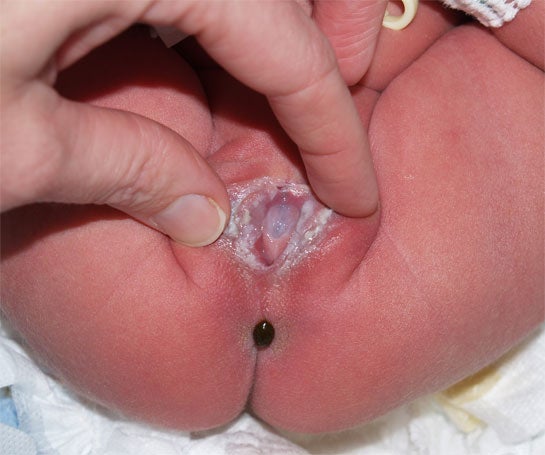
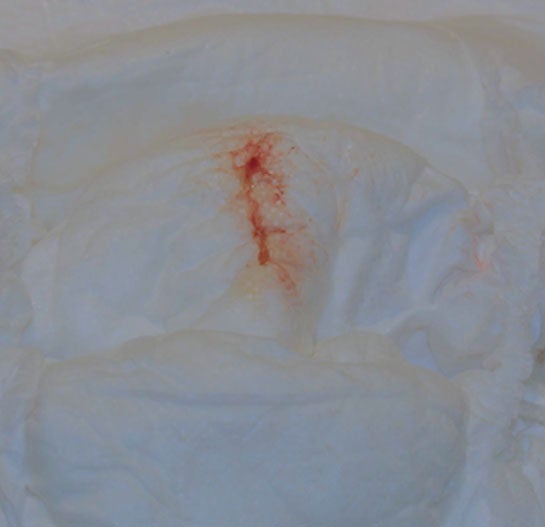
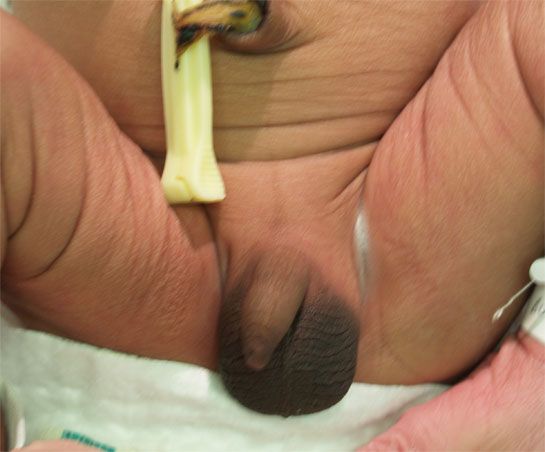
![hydrocele1[1].jpg](hydrocele1[1].jpg)
